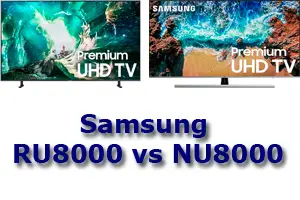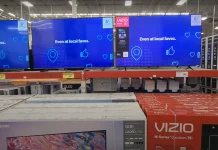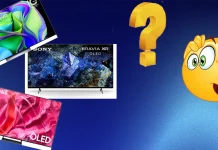The Samsung RU8000, released in 2019, is a successor to the NU8000 from 2018. However, despite being a newer model, user feedback highlights several significant drawbacks. One of the most noticeable differences is the sound quality. The NU8000 features a built-in subwoofer in addition to its two speakers, providing deeper bass and richer audio. In contrast, the RU8000 comes with only two speakers, resulting in weaker and less immersive sound.
Another major difference is in the brightness and contrast levels. The RU8000’s display is approximately 20-30% dimmer compared to the NU8000, which affects overall picture quality, especially in well-lit environments. This reduction in brightness and contrast is likely due to a change in the screen matrix technology, which plays a crucial role in color depth and image clarity.
Impact of the Screen Matrix on Picture Quality
The most significant technical difference between the two models lies in the type of screen matrix used. The NU8000 is equipped with an 8-bit matrix combined with FRC (Frame Rate Control) technology, which enhances color depth by simulating additional shades through backlight flickering. This method effectively increases the perceived color range, making images appear more vivid and dynamic.
In contrast, the RU8000 features a 10-bit matrix without FRC. While a true 10-bit panel should theoretically offer a broader color spectrum, the implementation in the RU8000 seems to result in lower overall contrast and weaker color vibrancy compared to its predecessor. The difference in dimming technology is also worth noting. The NU8000 uses Supreme UHD Dimming, while the RU8000 employs UHD Dimming, but these are largely marketing terms rather than substantial technical improvements. Similarly, the NU8000 utilizes Edge-lit LED technology, whereas the RU8000 is marketed with Ultra Slim Array, though both refer to edge-lit backlighting without major functional differences.
Additional Features and Software Improvements
One of the key upgrades in the RU8000 is the addition of support for Google Assistant and Amazon Alexa, allowing users to control their TV with voice commands and integrate it into a smart home ecosystem. This feature was not available in the NU8000, making the RU8000 more versatile for users who rely on voice assistants.
Aside from voice assistant support, other changes between the models are relatively minor. The operating system remains largely the same, with Samsung’s Tizen platform providing a familiar smart TV experience. The remote control design has also undergone some refinements, though these adjustments do not significantly impact usability.
While the RU8000 introduces some modern smart features, it falls short in critical areas such as sound quality, brightness, and contrast when compared to the NU8000. For users prioritizing picture and audio performance, the 2018 NU8000 may still be the better choice despite being an older model.
| QN75RU8000 (2019) | differences | QN75NU8000 (2018) | |
| screen | |||
| Screen Size | 74.5″ | 74.5″ | |
| Style | Flat Panel | Flat Panel | |
| Resolution | 3,840 x 2,160 | 3,840 x 2,160 | |
| screen bit | 10bit | ✅❗ | 10bit (8bits+FRC) |
| type screnn | premium | premium | |
| screen technology | VA | VA | |
| Backlighting | Ultra Slim Array (Edge) | ✅ | Edge-lit LED |
| Dimming Technology | UHD Dimming | ✅ | Supreme UHD Dimming |
| Stand Type (Color) | Flat Foot Simple | ✅ | T-Type Center Low |
| Bezel Width | SNB | ✅ | 3 Bezel-less |
| Video | |||
| Motion Rate | 240 | 240 | |
| refresh rate | 120 | 120 | |
| Color | Dynamic Crystal Color | Dynamic Crystal Color | |
| HDR (High-Dynamic Range) | HDR | ✅ | HDR Plus |
| Picture Engine | UHD Engine | UHD Engine | |
| Audio | |||
| Dolby | Yes | Yes | |
| Sound Output | 20W | 40W | |
| Woofer | No | Yes | |
| Speaker Type | 2CH | ✅❗ | 2.1CH |
| Multiroom Link | Yes | Yes | |
| Features | |||
| OS | Tizen 5.0 | ✅❗ | Tizen 4.0 |
| Wi-Fi | Yes | Yes | |
| Bluetooth | Yes | Yes | |
| Smart Hub | Yes (incl. Sports, Music and TV Plus) | Yes (incl. Sports, Music and TV Plus) | |
| Bixby | Yes | Yes | |
| Digital Clean View | Yes | Yes | |
| Ultra Black | No | No | |
| ConnectShare | Yes | Yes | |
| Closed Captioning | Yes | Yes | |
| Game Mode | Yes | Yes | |
| Eco Sensor | Yes | Yes | |
| Mobile to TV – Mirroring, DLNA | Yes | Yes | |
| Google Assistant | Yes | ✅❗ | No |
| Alexa | Yes | ✅❗ | No |
| Auto Channel Search | Yes | Yes | |
| InstaPort S (HDMI Quick Switch) | Yes | Yes | |
| Channel Guide | Yes | Yes | |
| Ambient Mode | No | No | |
| Auto Power Off | Yes | Yes | |
| AI Technology | No | No | |
| Apps Platform | Smart TV with Bixby Voice, Apps and Full Web Browser | Smart TV with Bixby Voice, Apps and Full Web Browser | |
| Auto Motion Plus | Yes | Yes | |
| Embedded POP | Yes | Yes | |
| Anynet+ (HDMI-CEC) | Yes | Yes | |
| V-Chip | Yes | Yes | |
| TV to Mobile – Mirroring | No | Yes | |
| USB HID Support | Yes | Yes | |
| AI Upscale | No | No | |
| Easy Pairing | No | ✅ | Yes |
| Inputs & Outputs | |||
| HDMI | 4 | 4 | |
| USB | 2 | 2 | |
| Ethernet | Yes | Yes | |
| RF In (Terrestrial/CableР’В | Yes | Yes | |
| RF In (Satellite Input) | Yes | Yes | |
| Digital Audio Out (Optical) | Yes | Yes | |
| Audio Return Channel SupportР’В | Yes | Yes | |
| One Connect | No | No | |
| Dimensions | |||
| Product Size (W x H x D) Without Stand | 66.3″ x 38″ x 2.4″ | ✅ | 65.9″ x 38″ x 2.3″ |
| Product Size (W x H x D) With Stand | 66.3″ x 40.5″ x 14.9″ | ✅ | 65.9″ x 41″ x 14.5″ |
| Product Weight With Stand | 87.7 lb. | ✅ | 87.3 lb |
| System | |||
| Digital Broadcasting | ATSC/ClearQAM | ATSC/ClearQAM | |
| Analog Tuner | Yes | Yes | |
| Accessories | |||
| Remote control | TM1950A | ✅❗ | TM1850A |






